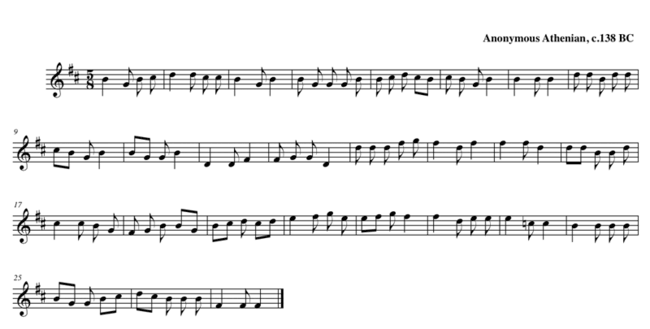.
The First Delphic Hymn was written to Apollo. It was found inscribed in stone in Delphi in 1893 by a French archaeologist; all that is known about its composer is that it was written by an Athenian, around 138 BC, since the part of the inscription giving the name of the composer is difficult to read. The Second Delphic hymn is slightly more recent, and has been dated to precisely 128 BC; evidently it was first performed in the same year. The name of the composer has also survived, in a separate inscription: Limenius. The occasion of the later hymn was the Pythian Festival, and the earlier hymn was probably written for the boys choir at the Pythian Games in 138 BC.

The first portion of the First Delphic Hymn, to be played on the kithara; the next section, not shown, is to be played on the aulos.
Media:1st_delphic_hymn.mid
The First Delphic Hymn is monophonic, consisting of a single melodic line, and it is in the cretic meter, which is quintuple, and it is in the Dorian mode — not the Dorian mode as known in the present day, but rather as it originally was in Ancient Greece, roughly corresponding to the present day Phrygian mode (the names of the modes were mixed up by Anicius Manlius Severinus Boethius, who translated ancient Greek theoretical writings into Latin in the 6th century, and the confusion has remained). In addition to being the earliest surviving substantial fragment of ancient music, the First Delphic Hymn is also the longest; unfortunately it is not a complete composition (the Seikilos epitaph, dated anywhere between the 2nd century BC and the 1st century AD, is the earliest surviving complete piece of music).
Exact performance practice is unknown, but Limenius is mentioned in a separate Delphic inscription as a master player of the kithara; likely he accompanied a singer or singers. While the kithara was used for the first section of the first hymn, the second section is to be performed on the aulos; it is also considerably chromatic. Whether the performer played the same music as the singer(s) in unison, or embellished the melodic line in a heterophonic texture, or played a drone, or improvised some form of counterpoint, are unknown; reconstructions of ancient Greek music are highly controversial, and the sources are often contradictory.
Photograph of the original stone at Delphi containing the second of the two hymns to Apollo. The music notation is the line of occasional symbols above the main, uninterrupted line of Greek lettering
References
- Warren Anderson/Thomas J. Mathiesen: "Limenius," Grove Music Online ed. L. Macy (Accessed August 24, 2005), (subscription access)
- Harvard Anthology of Music. Two volumes. Cambridge, Massachusetts, Harvard University Press, 1949. ISBN 0674393007
Recordings
Ancient Greek Music, Atrium Musicae de Madrid (1979), Harmonia Mundi
Music of Ancient Greece, Ensemble Kérilos, directed by Annie Bélis (1996), K617 Records
Links
| Ancient Greece
Science, Technology , Medicine , Warfare, , Biographies , Life , Cities/Places/Maps , Arts , Literature , Philosophy ,Olympics, Mythology , History , Images Medieval Greece / Byzantine Empire Science, Technology, Arts, , Warfare , Literature, Biographies, Icons, History Modern Greece Cities, Islands, Regions, Fauna/Flora ,Biographies , History , Warfare, Science/Technology, Literature, Music , Arts , Film/Actors , Sport , Fashion --- |
Retrieved from "http://en.wikipedia.org/"
All text is available under the terms of the GNU Free Documentation License

